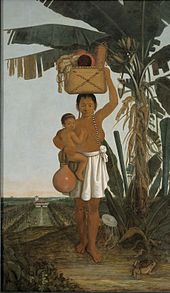Tupi (people)

The Tupi ( Portuguese : tupi, Spanish : tupí; pronunciation : [ tu'pi ]) were - next to the related Guaraní - one of the largest ethnic groups in Brazil before the colonial era and dominated the entire Atlantic coast at the time of the Conquista .
description
The Tupi did not form a political unit, but split up into a number of regional ethnic groups. They built houses out of wood and palm straw (maloca) and lived in villages enclosed by palisades (taba) . The Tupi lived mainly from agriculture - especially cassava and corn - and from fishing.
They were known to Europeans primarily through reports of their cannibalism , their constant wars with neighboring peoples, their nakedness and their sexual permissiveness. Some of the traditional reports - especially those on the extent of cannibalism - have now been questioned by researchers.
Their origins were probably in the Amazon , from where they spread to the Atlantic coast about 3000 years ago. Around 1500, when the first Portuguese arrived , the population was estimated to be one million. It settled tribes of approximately 300 to 2,000 people are different, examples are the Tupinambá and Potyguara.
From the sixteenth century on, the Tupi, like other indigenous people in the region, were proselytized by the Jesuits and, over time, assimilated. For many, however, colonialism meant enslavement or physical annihilation. Their language, the Tupi , served until the expulsion of the Jesuits in 1759, similar to the Guaraní in Paraguay to this day , as the general lingua franca in Brazil, also for the white settlers.
In northeastern Brazil, the Tupi made up a large proportion of the ancestors of today's Portuguese-speaking population. Descendants now live mainly in Paraíba , Pernambuco and Espírito Santo .
literature
- Stefan Rinke, Frederik Schulze: Small history of Brazil. Beck, Munich 2013, ISBN 978-3-406-64441-2 . ( online, p. 1761. )
See also
Web links
- Folk tales of the Tupi-Guarani tradition on staff.uni-mainz.de
Individual evidence
- ^ Franz Obermeier: Pictures of cannibals, cannibalism in pictures. Brazilian Indians in Pictures and Texts from the 16th Century (PDF; 114 kB). In: Yearbook for the History of Latin America , 38.Böhlau, Cologne / Weimar / Vienna 2001.
- ^ William Arens: The Man-Eating Myth: Anthropology & Anthropophagy. New York, Oxford University Press, 1979; ISBN 0-19-502793-0
- ↑ Jaisson Teixeira Lino: Escritas da Arqueologia Guarani no Sul do Brasil. ( Memento of the original from September 4, 2014 in the Internet Archive ) Info: The archive link was inserted automatically and has not yet been checked. Please check the original and archive link according to the instructions and then remove this notice. In: história e-história. Date: May 27, 2009 ISSN 1807-1783 . Retrieved August 31, 2014 (Portuguese).
- ↑ Fernando Amado Aymoré: The Jesuits in colonial Brazil. Catechesis as a cultural policy and a social phenomenon (1549–1760). Lang, Frankfurt am Main 2009, ISBN 978-3-631-58769-0 ( limited preview in Google book search), numerous passages.